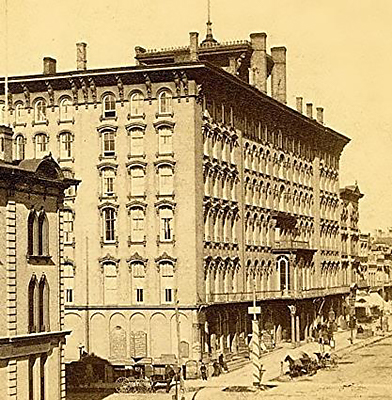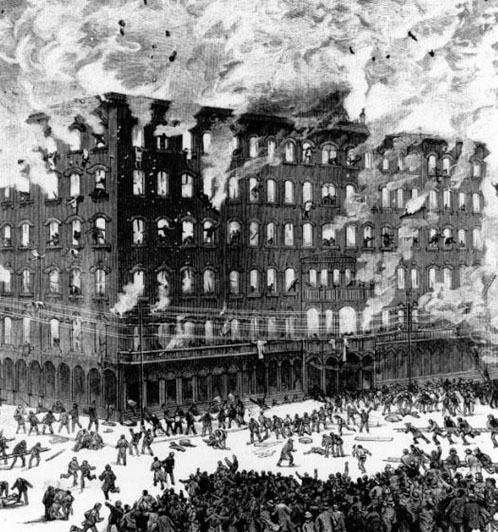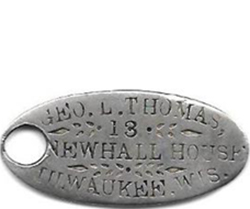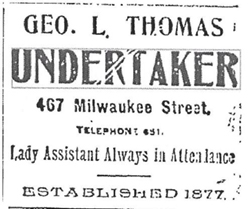
NOW Articles Written By Members
A look back at a common, but classic commemorative – Wisconsin’s Territorial Centennial
A side-tracked story: Mardi Gras Doubloons
A look back at a collecting specialty – the O.P.A. ration tokens of WWII
Bullion And Coin Tax Exemption – Act Now!
Is There A Twenty Cent Piece We Can Add To A Collection
Capped Bust Half Dollars: A Numismatic Legacy
U.S. Innovation Dollars: Our Most Under-Collected Coin?
My 2023 ANA Summer Seminar Adventure
In defense of the American Women's Quarters
A look back in numismatic history – the Hicksville Silver Dollar Hoard
The proofs so few of us collect: Jefferson Nickels
A look back in numismatic history – a story too good to be true
Kilroy promotes war bond sales
Just passing through a short-lived bank
The Kewaunee Line Encased Coin Folder
Lyman C. Draper: Collector, Historian, Genealogist
>> More articles in the Archive
For more NOW Articles Written By Members,
<< More articles in the Archive
A Token Of Tragedy
[by Tom Casper #982]

Newhall House. Erected 1857, destroyed by fire 1883
Milwaukee, Wisconsin was a wheat-trading center in the 1850’s. It came partly from its location to the grain fields and the honesty in weighing and grading wheat. Daniel Newhall, a capitalist and civic leader, was one of the principal wheat speculators. By the time he was thirty-five, he was the nation’s largest dealer in wheat.
In 1857 Newhall erected an elegant six-story hotel in downtown Milwaukee on the corner of N. Broadway and E. Michigan Streets. The Newhall House could accommodate 800 guests and was the second largest hotel in the city. The brick structure was surrounded by an ornate wood cupola and festooned with the Victorian gingerbread cornices, balconies and window framings common at the time. Mr. Newhall and the wheat commission merchants would meet in the evening at this hotel to buy and sell. Unfortunately, the Newhall House had been plagued with safety issues through the years which finally proved tragic. The hotel had two dozen smaller fires prior to 1883. The hotel staff was instructed not to arouse guests and evacuate them for a “minor” fire. The hotel was sold numerous times and fell into disrepair. Because it lacked ample outside fire escapes it became known as Milwaukee’s most notorious firetrap.
It was about 3:30AM on January 10, 1883 when a fire was discovered in the elevator shaft of the Newhall House. There was no house phone system and no local alarm. The first arriving firemen found guests starting to jump from the inferno from their sixth-floor rooms to their deaths. Others were hanging out the windows yelling for help. Flames roared up the wooden elevator shaft filling the building with heat and smoke. Few occupants were able to reach the fire escapes. Some escaped from lower floors using sheets and blankets.
No one knows how many people occupied the hotel that morning. The hotel register was never found to determine an exact count. Besides the forty maids, laundresses and kitchen help living on the fifth floor there about 180 guests in the hotel.

Newhall House Fire
The sketch of the Newhall House Fire dramatizes the rescue operation, illustrating the crowd gathered to watch and firefighters carrying ladders and holding safety nets for people trying to escape the flames.
A search of the ruins the next day turned up 47 corpses, only four of which were identifiable; some people were believed to be completely incinerated. Officially there were seventy-five listed as dead, forty-three of them unidentified and seven unaccounted for. It is believed that more than 100 people perished.
George Scheller, proprietor of the Newhall House Bar was arrested 6 days later on a warrant charging him with setting the fire to collect insurance but was later acquitted. A coroner’s inquest on February 5 blamed the hotel management for lack of fire escapes and ample exits but a grand jury found no negligence.
The hotel burned to the ground and the fire remained the deadliest hotel fire in U.S. for many decades. This key tag is a tragic reminder of the conflagration that took place that year. The fire became national news with a sketch of the burning building placed on the front covers of the January 20, 1883 edition of Leslie’s Newspaper and Harper’s Weekly.
Shown here is a personal key tag. It is stamped with the name of “Geo. L. Thomas, (Room) 13, Newhall House, Milwaukee, Wis”. It is nickel and measures 31mm x 15mm with a blank back. According to Milwaukee City Directories, Thomas lived in the Newhall House from 1868 – 1871 and was a bookkeeper for the Grover & Baker Sewing Machine Co. Luckily, he was no longer a hotel resident the morning of the fire. He later went to embalmer’s school and became an undertaker.

Geo. L. Thomas Key Tag. (Actual size: 31mm x 15mm)

Geo. L. Thomas ad in the Milwaukee Journal, Dec. 16, 1896
Have an interesting numismatic topic you’d like to share with your fellow NOW members?
Send your article to evan.pretzer@protonmail.com today!!!